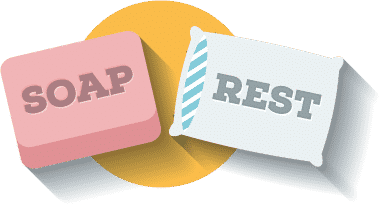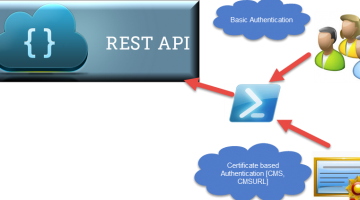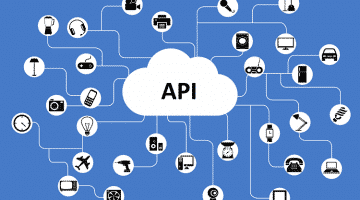REST and SOAP are elements often compared to each other in the design of client-server applications, but this is a mistake.
REST and SOAP are elements often compared to each other in the design of client-server applications, but this is a mistake. These elements are of different type: REST is an architecture style while SOAP is a protocol.
The major difference between these two elements is the degree of connection between the client and the server. A client developed with the SOAP protocol looks like computer software because it is closely related to the server. If a modification is made on one side or the other, the assembly may no longer function. Client updates should be made if there are changes to the server and vice versa.
A REST client knows how to use a standard protocol and methods. Its application must fit into this model. We don’t create additional methods, we use standardized methods that we develop for the type of media we need. There is consequently much less coupling between the client and the server: a client can use a REST type service without any knowledge of the API. Conversely, a SOAP client must know everything about the elements it will use during its interaction with the server, otherwise it will not work.
In addition, REST has specific characteristics that differentiate it from SOAP. REST is independent of a protocol. Both HTTP and FTP can be used, as long as it is a protocol with a standard scheme for a URI. REST is as standard as the elements you use to develop your application. If you use the HTTP protocol, then certain parts such as authentication or security will be standardized, as they are with HTTP.
Bottom of Form
If you want to develop an application that fully respects REST (this is called a RESTful application), you should know that your client only needs to know the API entry point and the type of data that is expected. APIs providing complete documentation with URL schemes are therefore not RESTful, because, by giving this documentation, they inform the customer about the possibilities of the API at a particular time of its existence. A modification of the API must therefore be documented otherwise this can lead to malfunctions.
When to use REST and when to use SOAP
While designing web services the most tarnished problem is when to utilize REST, or when to use SOAP.
The following are some of the key factors that determine when to use each technology for web services. REST services should be used when:
Bandwidth and resource limitations: SOAP messages are content rich and consume much higher bandwidth, so REST should be used when network bandwidth is a constraint.
Stateless: If you don’t need to maintain state of information between requests, you should use REST. SOAP is better suited for that purpose when you need a proper flow of information, where some of the information from one request goes to another. Take an online shopping site as an example. These sites typically require users to add the first item they purchase to their cart. All items in your cart are forwarded to the checkout page and your purchase is complete. This is an example of an application that requires status functionality.
Cache: If you need to cache many requests, REST is the best solution. In some cases, a customer can request the same resource multiple times. This can augment the number of needs sent to the attendant. By applying caching, you can stock up the consequences of the most often executed inquiry in a middle site. Therefore, the cache is checked first whenever the client requests a resource.
If the resource exists, the server will not continue. Therefore, caching can minimize the number of trips to your web server.
Ease of encryption: Encryption of REST services and following completion is not harder than SOAP. REST is a high-quality choice when you require a rapid fix for your web repair.
SOAP should be used when:
Asynchronous processing and post-invocation: The new SOAP 1.2 standard for SOAP 1.2 offers many additional features, especially when it comes to security, when customers have a requirement for a guaranteed level of reliability and security.
Formal means of communication: SOAP 1.2 provides a strict specification for this type of interaction when both the client and server agree on an exchange format. For example, an online shopping site that adds items to a cart before the user pays. We recommend that you always use the SOAP protocol when such scenarios exist.
SOAP challenges and REST API
It is provided by the browser in the client world and by the web service (SOAP or REST) in the server world.
Challenges of SOAP API
WSDL file: The major dispute of the SOAP API is the WSDL manuscript. The WSDL document tells the client everything that the web service can do. The WSDL documents hold all the data, together with the data types utilized in SOAP communication and all the processes available during the web service.
This represents the biggest challenge of WSDL files. This is a close agreement between the client and the server, indicating that changes can generally have a significant impact on client applications.
Document size: Another important issue is the size of the SOAP message transferred from the client to the server.
REST API challenges
Lack of Security: REST does not inflict the type of privacy like SOAP does. That’s why REST is so well suited to public URLs that are available, but REST is the worst mechanism used for web services when it comes to sensitive data passing between clients and servers.
Lack of state: Most web functions entail a crateful method. For example, if you have a shopping site with a mechanism that has a shopping cart, you need to know the number of items in the shopping cart before you actually make a purchase.
Choose between SOAP and REST
Using SOAP
- If your application requires high security
- Both consumers and suppliers must accept the specification format
Using REST
- Each operation, that is, create, read, update, and delete is independent of each other
- If you need to cache information
- Bandwidth is limited.



